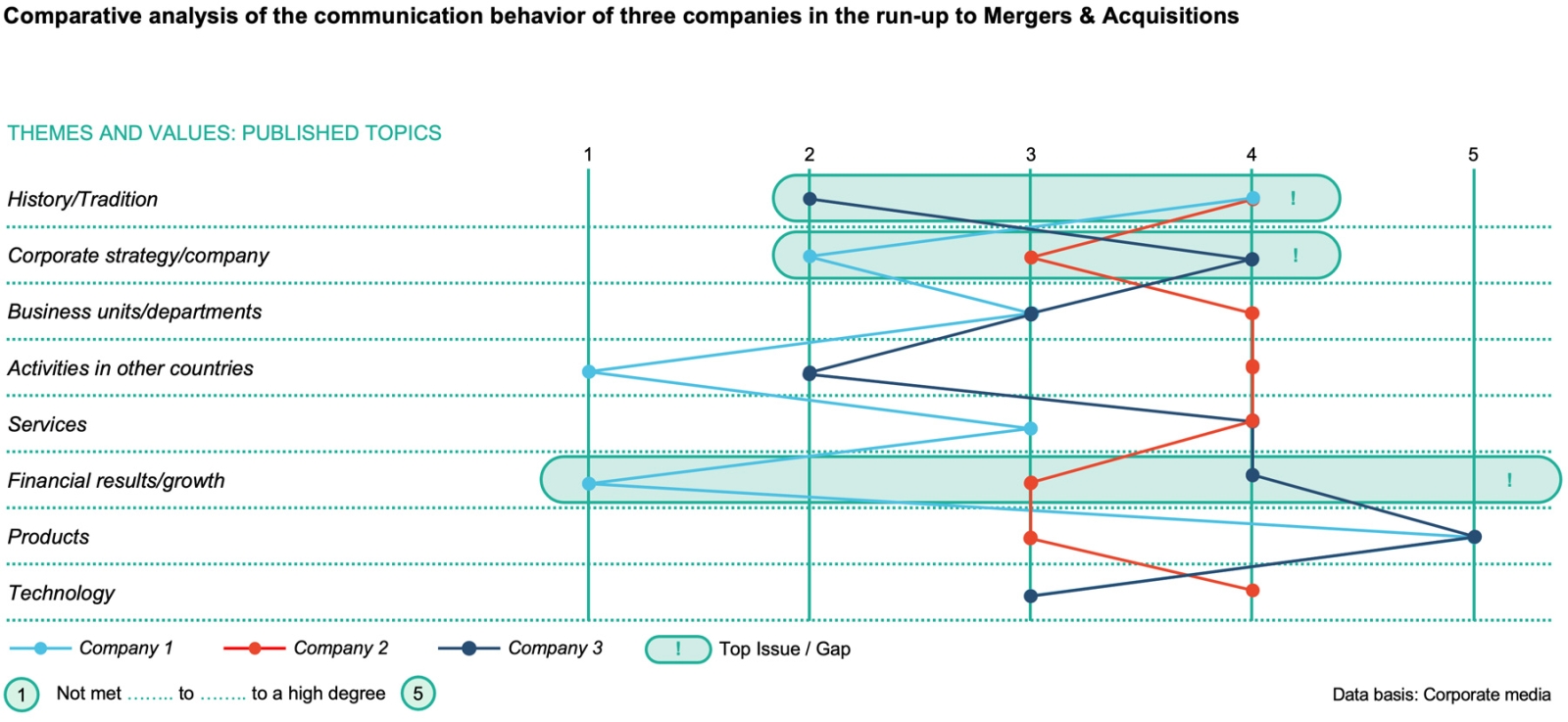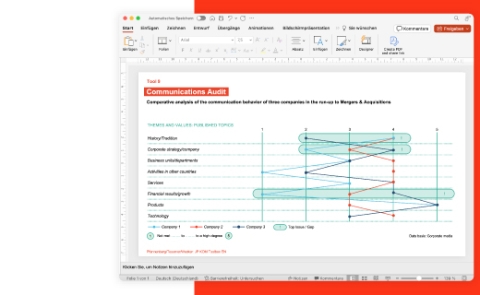Communications Audit

Guiding question
How effective is the company/companies' communication with stakeholders, especially in mergers & acquisitions (M&A)?
Objectives
- Assess the ability of organizations to send/receive and share information
- Identify strengths and weaknesses of individual communication tools
- Evaluate the ability of departments and employees to cooperate within/in the company
- Identify differences in communication behavior between companies, e.g., in the context of M&A
- Identify approaches for improving communication and individual communication tools
Implementation
The Communications Audit is a qualitative survey of companies' communications behavior. The subject of the audit can be the communications behavior of one company or - as part of a comparative analysis in preparation for M&A, for example - of several companies. In the latter case in particular, the communications audit is often combined with cultural due diligence (see Tool 8). Implementation will take the form of guided interviews with internal and/or external stakeholders of the company/companies.
Since, for reasons of antitrust law, no interviews can be conducted in advance of M&A at the company to be acquired, the audit in these cases is conducted by interviewing the M&A team from within the company. This team has had several days of contact with the acquisition target and with managers/employees of the target through discussions and in walk-throughs of the assets (e.g., production facilities) and has become familiar with the culture of the other company. Furthermore, artifacts such as memos, employee media, customer letters, the website, marketing materials, etc. are analyzed.
Since not every manager is a communications expert, questioning managers from one's own company about the takeover target is often done through indirect questions, as exemplified here about the communications culture: "When you asked an employee from the other company for his or her opinion, did he or she answer freely and independently and without prior consultation with his or her supervisor?" Techniques such as speech analysis according to Schulz von Thun (Tool 36) are used in the evaluation of artifacts.
Major topics of the survey may include:
- The vision and perceived mission of the stakeholders
- The perception of the content
- The evaluation of the company's communication behavior (by the stakeholders)
- The use and evaluation of the company's media offerings
- The perception of roles of management and other groups in the company and its environment in relation to communication
- Need for optimization in these areas
Elements of the Delphi method can be used, i.e. a second group of respondents is confronted with survey results from a first round of questioning and their opinion is sought.
The audit is conducted either by Corporate Communications or by a contracted consulting firm. In accordance with the qualitative survey method, the evaluation is carried out via the surveyed items by scoring the interviewees, and if necessary also the interviewer, on the basis of the answers given. Typically, the rating is done on a scale from 1 (strongly disagree) to 5 (strongly agree), alternatively in a polarity profile (see Tool 27). The proportion of descriptive result representations is large.
The main steps of a cultural due diligence are:
- The communication tools and practices in the company and its environment are collected and evaluated according to their thematic focus, target groups, frequency, reach, generation of stakeholder activities (feedback, linking, etc.).
- Preliminary research identifies the key issues, often in focus groups.
- The questionnaire is developed and the pretest is conducted.
- The survey is conducted and the interviews are recorded.
- A SWOT analysis (cf. Tool 21) is performed and recommendations are derived from it.
Theory: Qualitative social research
Social research distinguishes between qualitative and quantitative research methods - this mainly concerns sample selection, data collection and analysis. Quantitative methods characterize empirical social research: Empirical facts are presented numerically, conclusions are drawn from the empirical findings with the help of statistical methods.
Qualitative social research, on the other hand, is based on the collection and analysis of non-standardized data, often using interpretive and hermeneutic methods. Qualitative social research is in the tradition of phenomenological sociology or symbolic interactionism. Qualitative research takes into account the special character of social science subject areas through open data collection and interpretative data evaluation. A special focus is placed on the actor perspective as well as the actions and interpretive patterns of the interviewees.
The spectrum of qualitative methods ranges from software-supported text analyses to more codified methods (narrative analysis, hermeneutic sociology of knowledge, reconstructive social research, discourse analysis, objective hermeneutics) and open procedures of participatory field research to action research that specifically intervenes in the field.
While qualitative methods prefer open-ended questions, quantitative methods rely on closed and multiple-choice questions. Often the two types of methods are used in combination. (Cf. Wikipedia 2019, Merten 2008, Mayring 2002)
